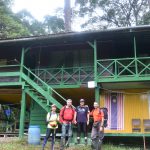 In July 25th, Gene was ready again for a new adventure. This time Gene travelled with Massimo Delledonne (University of Verona, Italy) and with Robert Jehle (University of Salford, UK) directly to Borneo. They spent 2 weeks in an incredible location, The Maliau Basin.
In July 25th, Gene was ready again for a new adventure. This time Gene travelled with Massimo Delledonne (University of Verona, Italy) and with Robert Jehle (University of Salford, UK) directly to Borneo. They spent 2 weeks in an incredible location, The Maliau Basin.
The Maliau Basin ecosystem comprises thousands of species of plants and animals, some of which are yet to be discovered and others can be found nowhere else in the world. They all form an intricate ecological network that not only makes the current survival of all organisms of the Basin possible, but also provide ecosystem services to human communities living in and around the area. And yet, despite the importance and uniqueness of the Maliau Basin, we know remarkably little about its biological composition. Despite field surveys and researches carried out in the past two decades, the biodiversity of the Maliau Basin has yet to be fully explored and documented. While there are records of the distribution (and sometimes abundance) of species of plants, birds and larger mammals within the mountain system, little is known of such organisms as amphibian and reptiles, fish, bats and rodents, pollinators insects, and virtually all other groups of terrestrial and aquatic invertebrates. Along with documented organisms not yet formally described, a large number of taxa still await scientific discovery.
In Maliau Basin there is a biological field station. Biological field stations have been centers of important scientific discoveries for a long time. They give researchers access to the environment that represents the object of their study, and accumulate multidisciplinary, place-based knowledge as a baseline to investigate aspects of an ecological community. Aside from the prospect of fundamentally new scientific discoveries, field stations also provide a knowledge base which enables to evaluate the causes and consequences of environmental change. Activities at field stations also transform the lives of students of all ages, and serve as training grounds for the next generation of scientific leaders. Finally, they are on the front lines of integrating science into decision-making and of communicating science to the general public.
We decided to accomplish this expedition to:
- Further test and apply Gene at Maliau Basin as a tool for the in-situ investigation of the genomic biodiversity harboured by a tropical rainforest.
- Establish a Gene permanent workshop at the Maliau Basin field station, both for basic research and as a training centre on genomics for local as well as international scientists.
The results were very positive. Again, Gene was able to sequence a biological sample directly collected from the tropical rainforest. Ovviously, everyday we are trying to improve Gene, with new components and new lab protocols, in order to optimize the results.
What will our next destination be? Stay tuned!!



